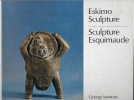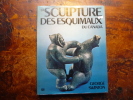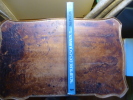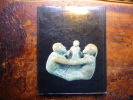22 books for « swinton a »Edit
-
Language
English (1)
French (21)
-
Century
18th (2)
19th (3)
20th (9)
21st (2)
-
Countries
Canada (1)
Denmark (3)
France (13)
Italy (1)
Spain (1)
Switzerland (3)
-
Syndicate
ALAC (1)
CLAQ (1)
ILAB (14)
NVVA (2)
SLACES (2)
SLAM (7)
Distant Electric Vision (+) Telegraphic Photography and Electric Vision (+) Telegraphic Photography and Electric Vision. - [THE FIRST DESCRIPTION OF AN ELECTRONIC METHOD OF PRODUCING TELEVISION]
London, Macmillan & Co, 1908. Royal8vo. Bound in contemporary half calf with five raised bands and two black leather title labels with gilt lettering to spine. In ""Nature"", May - October, 1908, Vol. LXXVIII [78]. Library label to first page of index and bookplate pasted on to front free end-paper. Fine and clean Fine and clean P. 151" Pp. 105-6. [Entire volume: LII, 686 pp.].
First printing of this seminal publication in the history of television" it is generally considered the earliest and most important paper in the early development of television. It constitutes the first description of an electronic method of producing television.Responding to an article in the June 4, 1908 issue of Nature by Shelford Bidwell entitled ""Telegraphic Photography and Electric Vision,"" A. A. Campbell Swinton wrote a letter to the editor of Nature proposing a solution to the most pressing problems in achieving ""distant electric vision"": ""This part of the problem of obtaining distant electric vision can probably be solved by the employment of two beams of kathode rays (one at the transmitting and one at the receiving station) synchronously deflected by the varying fields of two electromagnets placed at right angles to one another and energised by two alternating electric currents of widely different frequencies, so that the moving extremities of the two beams are caused to sweep simultaneously over the whole of the required surface within the one-tenth of a second necessary to take advantage of visual persistence."" (SWINTON).""The final, insurmountable problems with any form of mechanical scanning were the limited number of scans per second, which produced a flickering image, and the relatively large size of each hole in the disk, which resulted in poor resolution. In 1908 a Scottish electrical engineer, A. A. Campbell Swinton, wrote that the problems 'can probably be solved by the employment of two beams of kathode rays' instead of spinning disks. Cathode rays are beams of electrons generated in a vacuum tube. Steered by magnetic fields or electric fields, Swinton argued, they could 'paint' a fleeting picture on the glass screen of a tube coated on the inside with a phosphorescent material. Because the rays move at nearly the speed of light, they would avoid the flicker problem, and their tiny size would allow excellent resolution. Swinton never built a set (for, as he said, the possible financial reward would not be enough to make it worthwhile)..."" (Britannica). Hiers, Early Television no 366.
Distant Electric Vision (+) Telegraphic Photography and Electric Vision (+) Telegraphic Photography and Electric Vision. - [THE FIRST DESCRIPTION OF AN ELECTRONIC METHOD OF PRODUCING TELEVISION]
London, Macmillan & Co, 1908. Royal8vo. Bound in publisher's pictorial cloth. Gilt lettering and Nature's logo to spines and front board. In ""Nature"", May - October, 1908, Vol. LXXVIII [78]. Entire volumes offered. ""Emmanuel College"" in gilt lettering to spines. Two library stamps to title-page and first index page. A small tear to top of spine and signs after removal of label to spine. Very slight wear to extremities, otherwise a fine and clean copy. Rare in the publisher's binding. P. 151" Pp. 105-6. [Entire volume: LII, 686 pp.].
First printing of this seminal publication in the history of television" it is generally considered the earliest and most important paper in the early development of television. It constitutes the first description of an electronic method of producing television.Responding to an article in the June 4, 1908 issue of Nature by Shelford Bidwell entitled ""Telegraphic Photography and Electric Vision,"" A. A. Campbell Swinton wrote a letter to the editor of Nature proposing a solution to the most pressing problems in achieving ""distant electric vision"": ""This part of the problem of obtaining distant electric vision can probably be solved by the employment of two beams of kathode rays (one at the transmitting and one at the receiving station) synchronously deflected by the varying fields of two electromagnets placed at right angles to one another and energised by two alternating electric currents of widely different frequencies, so that the moving extremities of the two beams are caused to sweep simultaneously over the whole of the required surface within the one-tenth of a second necessary to take advantage of visual persistence."" (SWINTON).""The final, insurmountable problems with any form of mechanical scanning were the limited number of scans per second, which produced a flickering image, and the relatively large size of each hole in the disk, which resulted in poor resolution. In 1908 a Scottish electrical engineer, A. A. Campbell Swinton, wrote that the problems 'can probably be solved by the employment of two beams of kathode rays' instead of spinning disks. Cathode rays are beams of electrons generated in a vacuum tube. Steered by magnetic fields or electric fields, Swinton argued, they could 'paint' a fleeting picture on the glass screen of a tube coated on the inside with a phosphorescent material. Because the rays move at nearly the speed of light, they would avoid the flicker problem, and their tiny size would allow excellent resolution. Swinton never built a set (for, as he said, the possible financial reward would not be enough to make it worthwhile)..."" (Britannica). Siers & Siers, Early Television no 366.
VIAGGIO IN NORVEGIA IN DANIMARCA ED IN RUSSIA NEGLI ANNI 1788 89 90 E 91.
Tradotto dal Conte Luigi Bossi e con note del medesimo. Sonzogno, Milano, 1816. in-16 gr. (mm. 182x112), 4 voll. in 2 tomi, mz. pelle coeva con ang., fregi e tit. oro su due tasselli al dorso, conserv. brossure originali, pp. XXII,268,(2); 214,(2); 252,(2); 285; molto ben illustrati f.t., come da Indice, da 16 tavole di vedute e costumi, inc. in rame e colorate d'epoca. Sul 3° e 4° volume figura il seguente titolo: Viaggio da Pietroburgo a Mosca fatto nel 1805 dal Sig. REINBECK - Lettera sulla Norvegia contenente un quadro generale di quel Regno - Osservazioni di Storia Naturale e di Economia tratte dal viaggio in Norvegia di Gio. Cristiano FABRICIO - Compendio di un Viaggio in Danimarca ed in Svezia di Giuseppe MARSHALL, scudiere. Tradotti, o compilati, e corredati di note per servire di supplemento al Viaggio di SWINTON, dal Conte Luigi Bossi. L'opera fa parte della Raccolta di viaggi dopo quelli di Cook eseguiti tanto per mare quanto per terra, e non pubblicati finora in lingua italiana (Tomi XXV-XXVIII). Ben conservato, con barbe.
THE GREEN CURVE AND OTHER STORIES
Doubleday, Page & Company. 1914. In-8. Relié. Etat d'usage, Couv. légèrement passée, Dos frotté, Pliures. 303 pages. Couverture détachée. Annotations en page de garde. Tranche et bords supérieurs des derniers feuillets tachés (sans altération de la lecture).. . . . Classification Dewey : 420-Langue anglaise. Anglo-saxon
By Ole Luk-Oie Lieut. Colonel E.D. Swinton, D.S.O., R.E. Classification Dewey : 420-Langue anglaise. Anglo-saxon
SIXTY YEARS OF POWER, SOME MEMORIES OF THE MEN WHO WIELDED IT
Hutchinson. 1966. In-8. Relié. Etat d'usage, Couv. défraîchie, Dos satisfaisant, Intérieur acceptable. 253 pages. Photo en noir et blanc en frontispice (portrait). Illustré de nombreux dessins en noir et blanc hors texte (portraits). Ex-libris illustré en noir et blanc (Armoiries, David & Willa Chetwode, Corona Mea Christus) encollé en page de garde. Jaquette très abîmée.. Avec Jaquette. . . Classification Dewey : 420-Langue anglaise. Anglo-saxon
Philip Cunliffe-Lister, 1st Earl of Swinton (1884-1972). Classification Dewey : 420-Langue anglaise. Anglo-saxon
Campaigns of the Army of the Potomac. A critical history of operations in Virginia Maryland and Pennsylvania from the commencement to the close of the war 1861-1865
Revision and re-issue, original 8vo red cloth stamped in black and gilt, Charles Scribner's Sons, New York, 1862, 660-7 pp.
Good (spine a bit rubbed, ex-libris on guard)
Voyage en Norwège, en Danemarck, et en Russie. dans les années 1788, 89, 90 et 91. Traduit de l'anglais par P.-F. Henry ; suivi d'une lettre de Richer-Sérisy sur la Russie
Paris, chez F. Josse, 1798 2 tomes en 1 vol. in-8, VIII-320 et [2]-351 pp., demi-basane brune à coins, dos lisses ornés, tranches citron (reliure de l'époque). Des rousseurs, coins usés. Ex-libris Bibliothèque de M. Laplagne Barris. Bon exemplaire.
Première traduction française de ce voyage surtout anecdotique dans le Nord de l'Europe.La Lettre de Richer-Sérisy qui figure à la fin de l'ouvrage forme une très curieuse et énergique protestation contre les révélations des Anecotes sur la Cour de Russie de Rulhière, qui venaient juste de paraître (en 1797). L'auteur y défend, en pleine révolution, la mémoire de Catherine II. - - VENTE PAR CORRESPONDANCE UNIQUEMENT
TWENTY years after. The batlefields of 1914-1918: then and now.
London, George Newnes limited, 1938. 2 volumes. Tomes 1 et 2. VII. 720 pages. + pages 722-1532. Nombreuses illustrations in-texte. (28x22cm). Demi-basane à coins. Plats en toile. Dos à nerfs orné. Pièce de titre rouge. Tranches dorées. Gardes de papier marbré. Epidermures sans gravité sur le dos. Coupes frottées. Très bon état intérieur. Exemplaire particulièrement frais agréablement relié dans une demi-basane à coins. Texte entièrement rédigé en anglais et accompagné de nombreuses illustrations.
Sculpture of the Eskimo
Toronto McClelland & Stewart 1972
in-4 bien illustré noir et couleurs, 255p. Cartonnage de l'éditeur, toile et jaquette illustrée couleurs. :: Edition illustrée de 37 planches couleurs et de 770 phtos. :: Bon état. SIGNÉ par l'auteur.
Rachel Weisz Keanu Reeves Shia LaBeouf Max Baker Djimon Hounsou Pruitt Taylor Vince Peter Stormare Tilda Swinton Francis Lawrence Rachel Weisz Keanu Reeves
Reference : 60981
(2011)
ISBN : 7321950389414
Constantine (Édition simple)
Warner Bros 2011 19x13x2cm. 2011. DVD.
MERCI DE LIRE JUSQU'A LA FIN! Zone 2 Europe. Le boitier présente des trace de stockage et d'usure mais le CD reste en bon état de fonctionnement. Expedié soigneusement dans un emballage adapté depuis la France
Keanu Reeves Rachel Weisz Shia LaBeouf Djimon Hounsou Max Baker Pruitt Taylor Vince Tilda Swinton Peter Stormare Francis Lawrence Keanu Reeves Rachel Weisz
Reference : 89841
(2011)
ISBN : 7321950389414
Constantine (Édition simple)
Warner Bros 2011 19x13x2cm. 2011. DVD.
FRENCH édition : zone 2 Europe - - en bon état de lecture - Expédition sous blister dans une enveloppe matelassée depuis la France
1) The log of the sun. A chronicle of Nature’s Year. 2) The corridor of life. 3) Wild animals in Britain. Mammals, reptiles and amphibians. 3 vols ens.
London, Hodder and Stoughton, s. d., vers 1970, in-8vo, reliure en toile originale.

(SLACES, NVVA)
Phone number : 41 (0)26 3223808
Eskimo Sculpture / Sculpture Esquimaude - Envoi de l'auteur.
McClelland and Stewart Limited. 1965. In-4. Relié. Etat d'usage, Couv. convenable, Dos satisfaisant, Intérieur acceptable. 224 pages - jaquette en bon état - envoi de l'auteur sur la page de titre (photo disponible) - ouvrage en français et en anglais - nombreuses illustrations en noir et blanc et en couleurs dans et hors texte - quelques annotations au crayon à papier à l'intérieur de l'ouvrage sans conséquence sur la lecture - légères déchirures sur la jaquette.. Avec Jaquette. . A l'italienne. Classification Dewey : 730-Arts plastiques. Sculpture
Ouvrage en français et en anglais. Classification Dewey : 730-Arts plastiques. Sculpture
Voyage en Norwège, en Danemark et en Russie. Dans les années 1788, 89, 90 et 91. Traduit par F. Henry. Suivi d'une lettre de Richer-Sérisy, sur la Russie. Tome premier (de 2).
Paris, F. Josse, 1798, in-8°, VIII + 320 p., qqs. taches de l'eau, timbre bibl. sur ff. de titre, reliure en parchemin, pièce dse titre avec: Voyage, ceci avec pt. manque.

(SLACES, NVVA)
Phone number : 41 (0)26 3223808
Bath-Tub Vortex. - [THE CORIOLIS EFFECT ON A BATHTUB VORTEX]
London, Macmillian, 1962. Royal8vo. Bound in contemporary half calf with gilt lettering to spine. In ""Nature"", Vol. 196, October - December. Stamp to pasted down front end-paper and title-page. A fine copy. Pp. 1080-1. [Entire colume: LII, 1346 pp.].
First appearance of Shapiro's famous paper in which he sought to describe a bathtub vortex with the Coriolis Effect. This eventually gave birth to the urban myth that a toilet vortex always will have a counter clockwise flow in the Northern Hemisphere. The Coriolis effect on a micro level is still disputed and has never been satisfyingly confirmed or rejected. Scientists were aware that Earth's rotation alters the trajectory of objects in motion. This phenomenon causes low-pressure weather systems to twist counterclockwise in the Northern Hemisphere and clockwise in the Southern Hemisphere. The Coriolis effect, as it's known, had long been well documented as the cause of hurricanes and tornadoes. But despite previous attempts, no one had shown that the effect-first described in 1835 by the French engineer and mathematician Gustave-Gaspard Coriolis-works on very small scales as well. Though in theory it should influence bathwater's exit through a drain, the Coriolis effect was thought to be too small to see.""For his experiment, Shapiro used a circular, flat-bottomed tub with a centered drain hole three-eighths of an inch in diameter to which he attached a 20-foot length of hose, plugged with a stopper at the end. He filled the tank six inches deep with clean, room-temperature water. Small variations-air movement, a temperature change, a surface disturbance-create buoyancy currents that overshadow the Coriolis effect. So Shapiro did much tinkering to cancel out these possible sources of interference-covering the tank with a sheet of plastic to keep out air currents, for example, and carefully controlling the room's temperature. He also filled the tank by swirling water in clockwise, so that if the water drained counterclockwise, the direction would not have been influenced by how the tank was filled.After 24 hours of letting the water settle, Shapiro carefully pulled the plug from the end of the hose, gently placing above the drain a small float made of two crossed slivers of wood an inch long. It took about 20 minutes for the tub to drain completely. For the first 12 to 15 minutes, the float remained motionless. Then it began to rotate almost imperceptibly, counterclockwise, reaching a peak speed of approximately one revolution every three to four seconds. Proving that the Coriolis effect can be detected in a bathtub-size tank, albeit under carefully controlled conditions, was a remarkable achievement. At MIT's latitude of 42°, the effect was ""only thirty-millionths that of gravity, which is so small that it will be overcome by filling and even temperature differences and water impurities,"" reported one of many newspapers and periodicals covering the experiment. Shapiro's results were published in Nature and verified by colleagues who used his technique to demonstrate a clockwise flow in the Southern Hemisphere. The findings fascinated a curious public of all ages. Shapiro would also become known for explaining and improving the aerodynamics of golf ball dimples, as well as for helping to develop the intra-aortic balloon for heart patients and devices to treat blood clots, asthma, emphysema, and glaucoma. But for more than a decade after the bathtub test, he would receive letters and newspaper clippings from all over the world about what was dubbed the ""bathtub vortex"" controversy. "" (MIT Technology Review).
THE DEFENCE OF DUFFER'S DRIFT, A FEW EXPERIENCES IN FIELD DEFENCE FOR DETACHED POSTS WHICH MAY PROVE USEFUL IN OUR NEXT WAR
George Ronald. Non daté. In-8. Relié. Bon état, Couv. convenable, Dos satisfaisant, Intérieur frais. 62 pages. Illustré de cartes en noir et blanc hors texte. Eléments de la jaquette d'origine encollés au dos des plats, et annotations en page de garde.. . . . Classification Dewey : 420-Langue anglaise. Anglo-saxon
New edition. Forword by Field Marshal Earl WAVELL. Classification Dewey : 420-Langue anglaise. Anglo-saxon
VOYAGE EN NORWEGE EN DANEMARK ET EN RUSSIE DANS LES ANNEES 1788,89,90 ET 91 - EN DEUX TOMES - TOMES 1 + 2 .
CHEZ F.JOSSE / IMPRIMERIE DE CH.POUGENS. 1798. In-8. Relié plein cuir. Etat d'usage, Couv. convenable, Coiffe en pied abîmée, Intérieur frais. VIII + 320 pages + 351 pages - contre plats jaspés - titre, tomaison et ornements dorés sur le dos - coiffe en pied abîmée sur le tome 1 - 2 photos disponibles.. . . . Classification Dewey : 820-Littératures anglaise et anglo-saxonne
Traduit de l'anglais par P.F. Henry suivi d'une lettre de Richer-Sérisy sur la Russie. Classification Dewey : 820-Littératures anglaise et anglo-saxonne
Insect Variety: Its Propagation and Distribution. Treating of the Odours, Dances, Colours, and Music in all Grasshoppers, Cicadae, and Moths, Beetles, Leaf Insects, Bees, and Butterflies, Bugs, Flies, and Ephemerae....
1880 viii, 326, [8] p., 7 partly col. pls, col. frontispiece, publisher's decorated blue cloth.
Eskimo Sculpture - Sculpture Esquimaude
Texte en anglais et en français. Très nombreuses photos en noir et blanc et en couleurs. Manque de papier au plat inférieur de la jaquette. Cartonnage d'éditeur de toile sous jaquette illustrée. Bon Toronto McClelland 1965 1 volume in-4°
édition originale
Eskimo sculpture. Sculpture esquimaude.
Toronto, McClelland and Stewart 1965, 235x275mm, 224pages, reliure d'éditeur sous jaquette.
photos couleurs et n/b, Jaquette déchirée. Pour un paiement via PayPal, veuillez nous en faire la demande et nous vous enverrons une facture PayPal
Voyage en Norwège, en Danemarck, et en Russie, dans les années 1788, 89, 90 et 91. Traduit de l'anglais par P. F. Henry ; Suivi d'une lettre de Richer-Sérisy, sur la Russie.
P., F. Josse, 1798, 2 vol. in-8°, viii-320 et [4]-351 pp, reliures demi-veau à coins, pièces de titre et de tomaison chagrin carmin et noir, tranches jaunes (rel. de l'époque), reliures lég. frottées, annotations au crayon en marges, bon exemplaire
Edition originale de la traduction française de P. F. Henry. Relation traitant des moeurs, usages et coutumes, de l'économie, des arts, de la religion, dépeignant l'état actuel de la socièté des pays traversés. Bon exemplaire de cette traduction française augmentée d'un « Abrégé d'un voyage en Danemarck et en Suède, par Joseph Marshall » et d'un « Autre voyage de Marshall en Suède », Marshall étant un auteur connu en Angleterre pour ses ouvrages d'agriculture. La lettre rédigée par Richer-Sérisy, ami de Camille Desmoulins, est un véritable plaidoyer en faveur de la Russie, et de ses régents, réfutant un texte écrit par M. de Rhulières.
La sculpture des Esquimaux du Canada
In-4 relié pleine toile grise avec jaquette illustrée; dimensions 323 x 255 mm. Bon état. Seule la jaquette est usée par les frottements. Reliure et intérieur impeccables. 1,620 kg.
Les éditions La Presse, Montréal, 1976. Traduit de l'anglais par Jean-Paul Partensky. 37 planches en couleurs et 770 photographies en N&B. Table des matières en début de volume. 255 pp.
 Write to the booksellers
Write to the booksellers






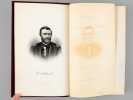






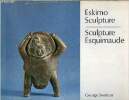
![Bath-Tub Vortex. - [THE CORIOLIS EFFECT ON A BATHTUB VORTEX]. "SWINTON, A. A. CAMPBELL.](https://static.livre-rare-book.com/pictures/LLX/59906_1_thumb.jpg)
![Bath-Tub Vortex. - [THE CORIOLIS EFFECT ON A BATHTUB VORTEX]. "SWINTON, A. A. CAMPBELL.](https://static.livre-rare-book.com/pictures/LLX/59906_2_thumb.jpg)
